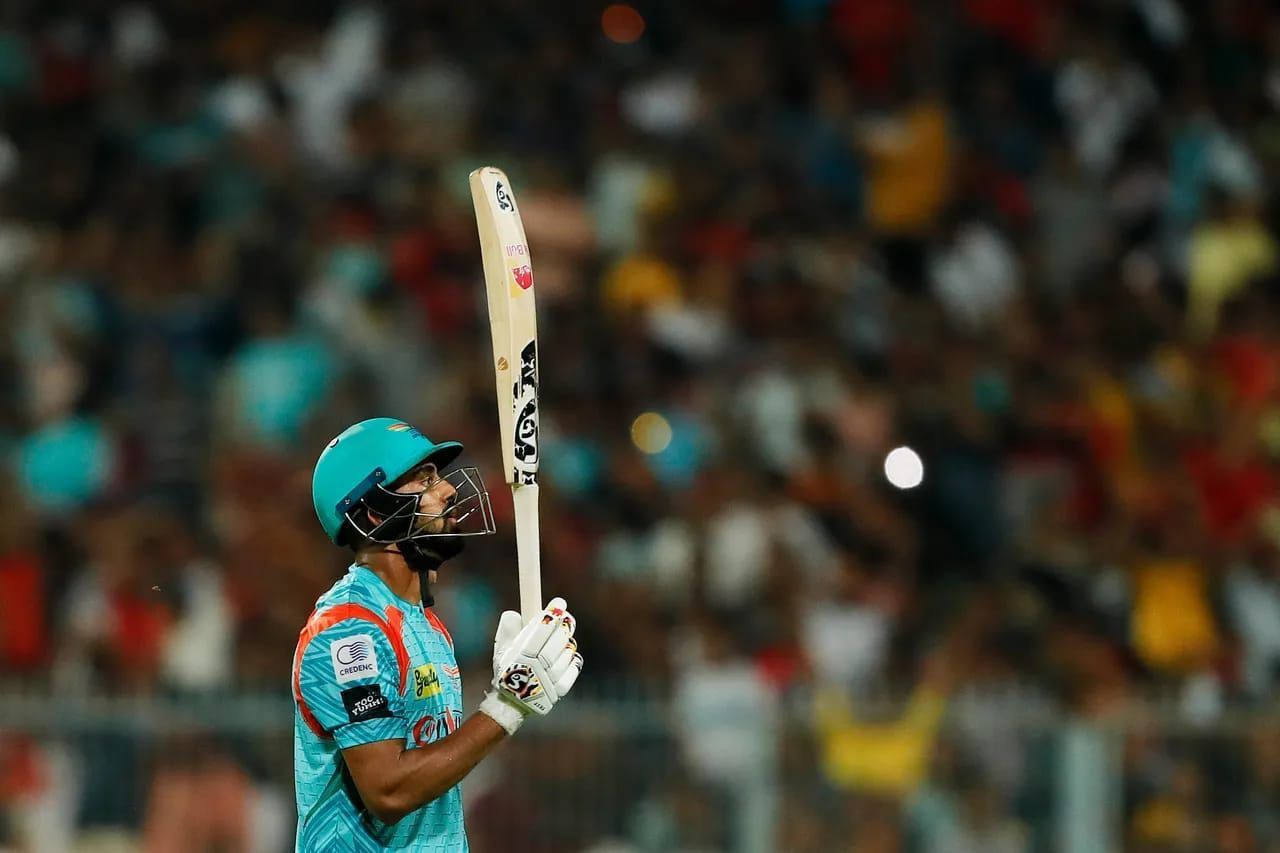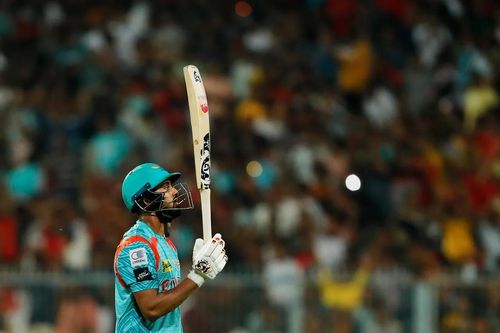
KL Rahul's runs might be causing his team more harm than good

Imagine having a batter in T20 cricket who could literally do anything and everything with the willow. He can smash fast bowlers for sixes into the sightscreen. He can be severe on short deliveries. He can scythe them to smithereens over backward point. He can whip them off his pads every day of the week. And if the situation demands, he can even lap, reverse scoop and paddle his way to eternal greatness.
Seems pretty good, eh?
Now imagine if that very batter has a tendency to not use all the tools at his disposal. He acknowledges the damage he can cause but he is very reluctant to do so, knowing that it could impact his personal performances.
There are still occasions when he feels comfortable enough to unfurl his entire repertoire of strokes, making millions gasp in awe. But more often than not, he hides them in his closet, hoping that the opposition, knowing how dangerous he can be, will be more circumspect than usual.
It is, in many ways, an illusion of fear that he is banking on. He is doing just enough to instil fear and make them worry about what lies ahead without really engaging it in regularly. It is working a charm, if scoreboards and records are the sole metric. He is averaging better than any other batter on the planet in the IPL, and he is racking up more than 500 runs almost every season.
For those who have still not joined the dots, the batter in question here is KL Rahul. Skipper of the Lucknow Super Giants. Ex-captain of the Punjab Kings. Possibly the future captain of India. And a perceived T20 batting mainstay across teams and tournaments.
Prima facie, there is absolutely nothing to make a case against Rahul, the T20 batter. He keeps scoring runs for whichever team he plays, and does so at the top of the order, meaning that his sides usually have a stable base to operate from. But is not as simple as that.
As soon as Rahul walks into a team environment, almost everyone sits up and takes notice. His talent alone is enough. But then he also backs them up with numbers and there isn’t really much to complain. However, most of the IPL teams he plays for end up losing the games that matter or don't win titles (IPL primarily).
The general consensus is that he’s been let down by his teammates frequently. To an extent, it is true, considering the Punjab Kings didn’t have the greatest middle order in the world in 2019, 2020 and 2021. Having said that, it is also paradoxical for a player of Rahul’s calibre to not have single-handedly led these teams to glory.
This season, with an almost free hand and with certainty that he would be skipper, Rahul had the opportunity to mould LSG to his liking. They bought plenty of batting cover and the glut of all-rounders meant that LSG almost always batted as deep as number eight. Jason Holder, who has a Test double hundred to his name, usually walked out to bat at that position. But Rahul still continued playing the role of an anchor – a role that can be reprised occasionally but is increasingly going out of vogue in modern-day T20 cricket.
It has worked on a couple of occasions – namely the twin hundreds Rahul scored against the Mumbai Indians. On both of those instances, he batted through the innings and ensured that LSG got to where they wanted to be. But there have been times when Rahul’s runs have actually been detrimental to his side.
Catch the latest IPL score here every day!
KL Rahul has played two perplexing knocks in succession
A few days before the Eliminator against the Royal Challengers Bangalore, Quinton de Kock blazed his way to 140* against the Kolkata Knight Riders. The South African scored that many off 70 balls. Rahul, who batted throughout the innings, mustered 68 runs off 51 balls.
LSG won that game. But only just. It came down to Evin Lewis' moment of magic. In all honesty, though, the game should’ve been put to bed when Rahul was crawling along at a very dodgy strike rate. But with LSG having already qualified and with the Rajasthan Royals not letting up, the result didn’t matter.
A few days later against RCB, it did matter. The pressure was amped up exponentially and LSG compounded their woes by conceding more than 200 runs. However, with de Kock, Rahul and a deep batting line-up (even without Holder), there was hope – even for the pragmatist.
Hope, though, was only contingent to Rahul throwing caution to the wind, grabbing the game by the scruff of its neck and dominating like he can. It was, if anything, the perfect moment to unfurl his entire repertoire of strokes. But, as has become the theme, he chose to keep them tucked firmly inside his pocket. It made an appearance intermittently, although it wasn’t nearly enough.
With LSG chasing 208 for victory, they needed to score 1.733 runs per ball. 10.4 runs per over for those attuned to calculating targets by the required run-rate. After 10 overs, Rahul was batting at a strike rate of 115.6, which is basically 1.15 runs per ball. At the end of the 15th over, he had gotten it up to 123.91 and 1.239, respectively. The required run rate, though, had zinged up to more than two runs per ball.
Rahul eventually perished having scored 79 runs off 58 balls – an innings that was, probably for the average cricket-watcher, a lone hand and a valiant face-saving knock for LSG. In truth, it was more counter-productive and sucked whatever momentum they should have generated.
79 runs off 58 balls meant that he scored 1.36 runs per ball in a run-chase that originally demanded 1.733 runs per ball. Had Rahul faced only 20 balls and fallen short, others would still have had time to alter the match dynamics. But he chewed up nearly half of the available deliveries but didn’t score half the number of runs.
This isn’t an innings in isolation either. And that is perhaps the worrying bit. Since storming his way to 659 runs at a strike rate of 158.41, he has not scored at a strike rate in excess of 140 throughout an IPL season. He has notched up more than 592 runs on each occasion but his teams have never even come close to competing.
T20 cricket is all about opportunity cost. The longer a batter bats, the greater impact he must have. If, for example, someone bats for more than 10 overs, he must contribute more than 50% of his team's runs because he is essentially taking that much time away from the rest of his teammates to leave a mark. And Rahul, unfortunately, hasn't been doing that often enough, meaning that his sides, especially the middle order, have struggled in the past few years.
The easy way out is to blame the middle order. Quip to the cameras that strike rate is overrated. Post the game against the Chennai Super Kings in Dubai (in 2021), he even said he felt he would be letting the team down if he played attacking cricket. Hey, maybe no one has said it but that is actually what his teammates might be craving for.
His teammates, of all people, would know the kind of destruction Rahul is capable of causing. He has strokes all around the dial and he can score at whatever tempo he wants to. The problem is that he wants to bat at a sedate tempo and wants to play on the illusion of fear, rather than the actual fear that he can tear any bowling unit to shreds.
There have been glimpses this season too. But whenever push has come to shove, Rahul has reverted to his old anchoring roots – a proclivity that has, in the aftermath of a botched run-chase, done his team more harm than good.
It’s just not happened with LSG. It has happened with PBKS in the past too. So, just hope it doesn’t happen when India travel Down Under hoping to bury their 2021 T20 World Cup ghosts. For that, though, Rahul has to look at himself in the mirror and ask himself if this is really what he thinks his team needs.
He can have all the strokes in the book. He can have all the purists going gaga over every shot he executes. He can have millions of fans who drool each time he upstages himself with an extraordinary stroke. But if he isn’t ready to unfurl them every time he walks out to bat, his and his team’s fortunes will remain inversely proportional.